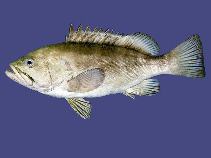| Family: |
Epinephelidae (Groupers) |
| Max. size: |
137 cm TL (male/unsexed); max.weight: 55 kg |
| Environment: |
reef-associated; marine; depth range 9 - 300 m |
| Distribution: |
Western Indian Ocean: Kenya to Knysna, South Africa and the Kerala coast of India; however, there are no records between Kenya and Durban, nor between Kenya and India. Record from Djibouti (Ref. 5450) is doubtful. |
| Diagnosis: |
Dorsal spines (total): 11-11; Dorsal soft rays (total): 13-14; Anal spines: 3-3; Anal soft rays: 8-9. Distinguished by the following characteristics: variable coloration depending on size and depth of capture: head and body greyish brown for specimens up to 35 cm SL, shading to pale purplish grey ventrally, with three broad dark bars between the dorsal fin and lateral line; broad dark blotch dorsally on the caudal peduncle, reaching about halfway to the lateral line; specimens from deep water 88-115 cm SL with rosy slate or chocolate brown; throat and hidden membranes of head pinkish grey; without bars, spots or blotches; body depth 2.5-2.8 times in SL; head length 2.3-2.6 times in SL; convex interorbital area; angular preopercle; convex upper edge of operculum; posterior nostril diameter 2-4 times larger than anterior nostril; scaly maxilla, reaching to or slightly past vertical at rear edge of eye; 2 rows of teeth in midlateral part of lower jaw in 20-56 cm SL fish and 3-4 rows in 70-90 cm SL fish; caudal fin truncate; ctenoid lateral body scales, auxiliary scales sparse or absent on body scales (Ref. 089707). |
| Biology: |
Along the South African coast, it occurs on rocky bottoms at depths of 9 to at least 55 m; off the coast of Kenya it occurs below the major thermocline at 125 to 200; also known from deep waters off the Kerala coast of India at 250 to 300 m. Occurrence off the coasts of Kenya and India appears to be an example of 'tropical submergence' by which temperate species are able to live at tropical latitudes only in the cooler deep-water zone. |
| IUCN Red List Status: |
Least Concern (LC); Date assessed: 22 November 2016 Ref. (130435)
|
| Threat to humans: |
harmless |
Source and more info: www.fishbase.org. For personal, classroom, and other internal use only. Not for publication.

